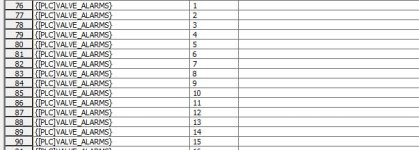I've got an array valve_set which has a data type of BOOL[32].
I've got another array valve_set_init which also has a data type of BOOL[32].
I'd like valve_set_init to have a constant value of, let's say, [1,0,0,1,1,0,...etc].
At various times, including (but not limited to) at startup, I'd like to make valve_set equal to valve_set_init.
Two questions:
1. What's the best way to set the initial (constant) value for valve_set_init?
2. What's the best way to copy valve_set_init into valve_set?
I've tried the COP (and CPS) instructions, but I get the following error:
Thanks!
I've got another array valve_set_init which also has a data type of BOOL[32].
I'd like valve_set_init to have a constant value of, let's say, [1,0,0,1,1,0,...etc].
At various times, including (but not limited to) at startup, I'd like to make valve_set equal to valve_set_init.
Two questions:
1. What's the best way to set the initial (constant) value for valve_set_init?
2. What's the best way to copy valve_set_init into valve_set?
I've tried the COP (and CPS) instructions, but I get the following error:
Error: Rung 1, COP, Operand 0: Invalid data type. Argument must match parameter data type.
Thanks!




